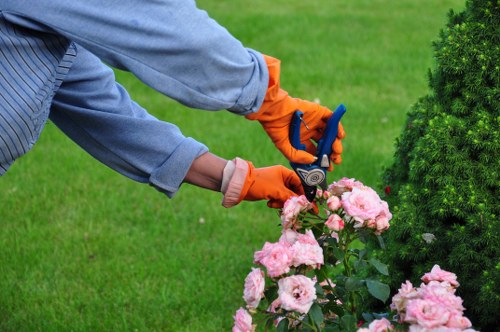Comprehensive Guide to Garden Maintenance in Fairfield
Introduction to Garden Maintenance

Maintaining a beautiful garden in Fairfield requires dedication, knowledge, and the right techniques. Whether you're a seasoned gardener or a beginner, understanding the fundamentals of garden care can transform your outdoor space into a thriving oasis.
Garden maintenance involves a variety of tasks, from planting and pruning to pest control and soil management. Each activity plays a crucial role in ensuring your garden remains healthy and aesthetically pleasing throughout the year.
In this article, we'll explore essential garden maintenance practices tailored specifically for Fairfield's unique climate and soil conditions.
Seasonal Garden Care

Spring Maintenance
Spring is a critical time for garden maintenance in Fairfield. As the weather begins to warm, it's essential to prepare your garden for the growing season.
Start by cleaning up any debris from the winter months. Remove dead leaves, branches, and any spent plants to make room for new growth.
Now is also the time to assess and amend your soil. Adding compost or organic matter can enhance soil fertility, providing a strong foundation for your plants.
Summer Care
Summer brings intense heat and potential drought conditions. Proper watering strategies are vital to keep your garden thriving.
Implement drip irrigation or soaker hoses to ensure deep watering with minimal evaporation. Mulching around plants can also help retain moisture and regulate soil temperature.
Regularly monitor for pests and diseases, addressing issues promptly to prevent extensive damage.
Autumn Maintenance

As temperatures drop, autumn provides an opportunity to prepare your garden for the colder months. Start by planting perennials and bulbs that will bloom in the spring.
Pruning is also essential. Remove any dead or diseased branches to promote healthy growth in the coming year.
Finally, protect sensitive plants by mulching and covering them to shield against frost and freeze.
Winter Care
Winter may appear dormant, but proper garden maintenance continues during the colder months. Focus on protecting your garden infrastructure.
Ensure that any garden structures, such as sheds or greenhouses, are secure and free from damage. Additionally, plan for the upcoming gardening season by researching new plant varieties and designs.
By maintaining your garden year-round, you ensure its long-term health and beauty.

Essential Garden Tools and Equipment

Hand Tools
Having the right hand tools is fundamental for effective garden maintenance. Essential tools include:
- Pruning Shears: Perfect for trimming and shaping plants.
- Hand Trowel: Ideal for digging small holes and transplanting.
- Garden Fork: Useful for aerating soil and turning compost.
Power Tools
For larger tasks, power tools can save time and effort. Consider investing in:
- Lawn Mower: Keeps your lawn neat and healthy.
- Hedge Trimmer: Efficiently trims and shapes hedges and shrubs.
- Leaf Blower: Quickly clears leaves and debris from pathways and lawns.
Maintenance Tips
Regularly maintain your garden tools to ensure longevity and performance. Clean tools after each use, sharpen blades as needed, and store them in a dry, accessible place.
Soil Management and Fertilization
Understanding Soil Types
Fairfield's soil can vary, but understanding its composition is key to successful gardening. Common soil types include loamy, clay, and sandy soils.
Loamy soil, rich in organic matter, is ideal for most plants. Clay soil retains moisture but may require amendment to improve drainage. Sandy soil drains quickly but may need additional fertilization to retain nutrients.
Amending Soil
Enhancing your soil with organic matter such as compost or manure can improve its structure and fertility. This practice promotes healthy root development and nutrient uptake.
Consider conducting a soil test to determine its pH and nutrient levels. Based on the results, you can make informed decisions about amendments and fertilizers.
Fertilization Strategies
Proper fertilization ensures that your plants receive the necessary nutrients for growth. Use a balanced fertilizer that provides essential elements like nitrogen, phosphorus, and potassium.
Apply fertilizers according to the specific needs of your plants and the recommendations of your soil test. Over-fertilization can harm plants and negatively impact the environment.
Pest and Disease Management
Identifying Common Pests
Pests can pose significant challenges to garden health. Common pests in Fairfield include aphids, caterpillars, and slugs.
Regularly inspect your plants for signs of infestation, such as chewed leaves, discoloration, or the presence of the pests themselves.
Natural and Chemical Controls
Implement integrated pest management (IPM) strategies to control pests effectively and sustainably. Natural controls include introducing beneficial insects, such as ladybugs, which prey on harmful pests.
If necessary, use chemical pesticides judiciously, following label instructions to minimize environmental impact.
Preventing Disease
Prevent plant diseases by maintaining proper garden hygiene. Remove any diseased plant material promptly and ensure adequate spacing for air circulation.
Use disease-resistant plant varieties and avoid overhead watering to reduce the risk of fungal infections.
Lawn Care and Maintenance
Grass Selection
Selecting the right type of grass is foundational for a healthy lawn in Fairfield. Common choices include Kentucky bluegrass, perennial ryegrass, and tall fescue.
Each grass type has its own growth patterns and maintenance requirements. Choose one that aligns with your lawn's usage and the local climate conditions.
Mowing Practices
Regular mowing is essential for maintaining a lush lawn. Aim to mow your grass to a height of 2.5 to 3.5 inches, depending on the species.
Ensure your mower blades are sharp to make clean cuts, reducing stress on the grass.
Weed Control
Weeds compete with your grass for nutrients and water. Implement a combination of manual removal and herbicide application to manage weed growth.
Prevention is key—maintain healthy grass to naturally resist weed invasion.
Plant Selection and Landscaping
Choosing the Right Plants
Select plants that thrive in Fairfield's climate and soil conditions. Consider factors such as sun exposure, water requirements, and growth habits when selecting your garden flora.
Incorporate a mix of perennials, annuals, shrubs, and trees to create a dynamic and resilient landscape.
Design Principles
Apply fundamental design principles to enhance the visual appeal of your garden. Focus on balance, contrast, and harmony to create a cohesive and inviting space.
Incorporate focal points, such as specimen plants or garden structures, to draw the eye and add interest.
Hardscaping Elements
Integrate hardscaping features like pathways, patios, and fences to complement your plantings and provide functional spaces.
Choose materials that match the style of your home and withstand Fairfield's weather conditions.
Watering and Irrigation Systems
Efficient Watering Techniques
Efficient watering is crucial for garden health and conservation. Adopt practices that minimize water waste and ensure deep root hydration.
Water early in the morning to reduce evaporation and allow plants to absorb moisture before the heat of the day.
Installing Irrigation Systems
Consider installing irrigation systems, such as drip irrigation or sprinklers, to streamline your watering routine.
Automated systems can be programmed to deliver consistent moisture, improving plant health and reducing manual labor.
Rainwater Harvesting
Harvesting rainwater is an eco-friendly way to water your garden. Set up rain barrels or cisterns to collect and store rainwater for later use.
This practice not only conserves water but also reduces your utility bills.
Mulching and Weed Control
Benefits of Mulching
Mulching offers numerous benefits, including moisture retention, temperature regulation, and weed suppression. It also enhances the aesthetic appeal of your garden beds.
Choose organic mulches, such as wood chips or straw, which break down over time and enrich the soil.
Applying Mulch
Apply a 2-3 inch layer of mulch around your plants, ensuring it doesn't touch the stems or trunks to prevent rot and disease.
Replenish mulch as needed to maintain its effectiveness and appearance.
Organic vs. Inorganic Mulch
Organic mulches decompose and improve soil structure, while inorganic mulches, like gravel or rubber, offer longer-lasting weed control without enriching the soil.
Choose the type that best fits your garden's needs and your maintenance preferences.
Pruning and Trimming Techniques
When to Prune
Proper timing is essential for effective pruning. Generally, prune in late winter or early spring before new growth begins.
However, some plants may require summer pruning to remove dead or overgrown branches.
Pruning Methods
Use clean, sharp tools to make precise cuts, reducing the risk of infection and promoting healthy regrowth.
Follow the natural shape of the plant, removing no more than one-third of its growth at a time.
Tools and Safety
Invest in high-quality pruning tools, such as shears, loppers, and saws. Regularly maintain and sanitize your tools to ensure safety and efficiency.
Wear protective gear, including gloves and safety glasses, to prevent injuries while pruning.
Composting and Soil Health
Benefits of Composting
Composting transforms kitchen scraps and garden waste into nutrient-rich soil amendment. This practice enhances soil structure, fertility, and microbial activity.
Using compost reduces the need for chemical fertilizers and promotes sustainable gardening.
Setting Up a Compost Bin
Create a compost bin in a shaded area of your garden. Layer green materials (like vegetable scraps) and brown materials (such as dried leaves) to maintain a balanced carbon-to-nitrogen ratio.
Turn the compost regularly to aerate it and speed up decomposition.
Using Compost in Your Garden
Incorporate finished compost into your soil before planting or as a top dressing around established plants. It improves moisture retention and provides essential nutrients.
Compost can also be used to create healthy potting mixes for container gardening.
Integrated Pest Management (IPM)
What is IPM?
Integrated Pest Management is a sustainable approach to controlling pests by combining biological, cultural, and chemical methods.
The goal is to manage pest populations at acceptable levels while minimizing harm to the environment and non-target organisms.
Biological Controls
Introduce natural predators, such as beneficial insects, to keep pest populations in check. Ladybugs, for example, are effective against aphids.
Cultural Practices
Implementing crop rotation, selecting pest-resistant plant varieties, and maintaining garden hygiene are cultural practices that reduce pest incidence.
Chemical Controls
Use chemical pesticides as a last resort. Choose environmentally friendly options and apply them according to manufacturer instructions to minimize negative impacts.
Enhancing Garden Aesthetics
Color and Harmony
Choose a color palette that complements your home's exterior and creates visual harmony. Mixing different hues can add depth and interest to your garden.
Garden Structures
Incorporate structures like pergolas, trellises, or arbors to add vertical interest and provide support for climbing plants.
Lighting
Outdoor lighting enhances the beauty of your garden after dark. Use solar-powered lights, string lights, or spotlights to highlight key features.
Sustainable Gardening Practices
Water Conservation
Implementing water-saving techniques, such as rainwater harvesting and efficient irrigation systems, promotes sustainability in your garden.
Organic Gardening
Opt for organic gardening methods by avoiding synthetic chemicals and focusing on natural fertilizers and pest control.
Biodiversity
Encourage biodiversity by planting a variety of species, including native plants, which support local wildlife and create a resilient ecosystem.
Local Climate Considerations
Fairfield's Climate
Understanding Fairfield's temperate climate is essential for effective garden maintenance. The region experiences four distinct seasons, each presenting unique challenges and opportunities for gardening.
Adapting to Weather Patterns
Adapt your gardening practices to local weather patterns. For instance, prepare for summer heat with drought-tolerant plants and protect against winter frosts with appropriate coverings.
Microclimates
Identify microclimates within your garden, such as shaded areas or spots with higher wind exposure. Tailor your plant selections and maintenance strategies accordingly.

Top 15 Nearby Areas to Fairfield for Garden Maintenance Services
Fairfield is surrounded by several communities that benefit from expert garden maintenance services. Here's a look at the top nearby areas:
- Torrance: Located just south of Fairfield, Torrance offers a mix of residential and commercial properties requiring diverse gardening solutions.
- Dublin: Northeast of Fairfield, Dublin is known for its expansive parks and well-maintained private gardens.
- Livermore: Famous for its vineyards, Livermore's gardens often require specialized care to thrive.
- Winters: West of Fairfield, Winters features lush landscapes that benefit from regular maintenance.
- Alamo: A short distance southeast, Alamo's upscale gardens demand high-quality maintenance services.
- Lafayette: North of Fairfield, Lafayette's botanical gardens and residential areas require meticulous care.
- Hayward: East of Fairfield, Hayward's diverse climate zones necessitate adaptable gardening strategies.
- Vacaville: Southwest, Vacaville's sprawling estates and public gardens often seek professional maintenance.
- Brentwood: Northeast, Brentwood's traditional and modern gardens benefit from expert upkeep.
- San Ramon: Northeast, San Ramon hosts numerous community gardens that require regular attention.
- Concord: Northwest, Concord's urban gardens and green spaces are popular and need specialized maintenance.
- Danville: Southeast, Danville's picturesque landscapes are a testament to effective garden care.
- Pleasanton: East, Pleasanton's well-maintained gardens reflect the area's commitment to beauty and sustainability.
- Walnut Creek: Northeast, Walnut Creek's vibrant gardens and parks are meticulously maintained.
- Martinez: Southwest, Martinez's historic gardens require careful preservation and maintenance.
Each of these areas presents unique gardening needs, making professional garden maintenance services in Fairfield a valuable resource for residents.
Choosing the Right Garden Maintenance Service
Experience and Expertise
Select a garden maintenance service with proven experience in the Fairfield area. Knowledge of local plants, soil types, and climate conditions is essential for effective care.
Comprehensive Services
Opt for providers that offer a wide range of services, including pruning, fertilization, pest control, and landscaping. Comprehensive services ensure all aspects of your garden are well-maintained.
Customer Satisfaction
Check reviews and seek recommendations to gauge customer satisfaction. A reputable service will have positive feedback and a track record of excellence.
Customized Plans
Choose a service that tailors its offerings to your garden's specific needs. Customized maintenance plans ensure your garden receives the attention it requires.
Pricing and Value
Compare pricing structures to find a service that offers value without compromising quality. Transparent pricing and detailed quotes are signs of a trustworthy provider.
Conclusion
Effective garden maintenance in Fairfield involves a combination of proper techniques, the right tools, and a deep understanding of the local environment. By following the guidelines outlined in this article, you can ensure your garden remains healthy, vibrant, and beautiful throughout the year.
Whether you're tending to a small backyard or managing a large estate, investing time and resources into garden care will yield rewarding results.
Ready to transform your garden? Contact us today to book your garden maintenance services and let our experts help you achieve the garden of your dreams.
